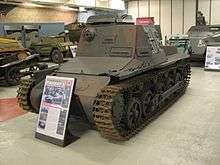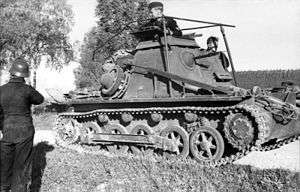SdKfz 265 Panzerbefehlswagen
| Panzerbefehlswagen | |
|---|---|
|
Panzerbefehlswagen on Panzer I Ausf. B chassis | |
| Type | Light tank |
| Place of origin |
|
| Service history | |
| In service | 1939–1945 |
| Used by |
|
| Wars | Second World War |
| Production history | |
| Designed | 1938 |
| Manufacturer | Krupp, Daimler-Benz |
| Produced | 1938–1939 |
| Number built | 190 |
| Specifications | |
| Weight | 5.8 tonnes (6.4 short tons; 5.7 long tons) |
| Length | 4.445 m (14 ft 7.0 in) |
| Width | 2.08 m (6 ft 10 in) |
| Height | 1.72 m (5 ft 8 in) |
| Crew | 3; Commander, Driver and Radio Operator |
|
| |
| Armor | 6 to 13 mm (0.24 to 0.51 in) |
Main armament | One 7.92 mm MG13 machine gun |
| Engine |
Maybach NL38TR four cylinder air cooled gasoline engine. 100 hp |
| Suspension | Quarter-elliptical leaf spring suspension. |
Operational range | 290 km (180 mi) |
| Speed | 40 km/h (25 mph) on-road |
The SdKfz 265 Panzerbefehlswagen was the German Army's first purpose-designed command tank, and the primary German command tank in service at the beginning of World War II. Converted from the Panzer I Ausf. B, the SdKfz 265 saw considerable action during the early years of the war.
History
The SdKfz 265 was designed to fulfil a growing need within the German Army for a command tank, following the realization that the leaders of a massive panzer formation would themselves have to travel in a tank of some type. This vehicle would have to carry extra equipment and personnel to assist the field commander in his duties.
In 1935 Krupp offered a command tank design based on the existing Panzer I Ausf B chassis. The Ausf. B was slightly longer than the Panzer I Ausf A and lent itself easily to conversion into a command vehicle.
Design
To increase space for a radio operator the rotating turret of the PzKpfw IB was eliminated and replaced with a larger fixed "box" superstructure. This allowed room for map boards, paperwork and a more powerful FuG6 radio transmitter in addition to the earlier FuG2 radio (Panzer I's had only FuG2 radio receivers). Despite these modifications the vehicle's interior remained small, a factor leading to its rapid replacement by conversions of larger tanks. The cramped quarters also made operation of the vehicle's single ball-mounted MG13 or MG34 machine gun virtually impossible. Because of this, most SdKfz 265 were also equipped with pistol ports, and many had their machine guns removed entirely. A large frame antenna was mounted to the hull of many early version SdKfz 265s. The antenna gave the upgraded radio transmitter units better range and reception.
Because it would be necessary for a command tank to keep up with the tanks under its command, the original 60 hp Krupp M305 gasoline engine of the Panzer I was replaced by the more powerful 100 hp Maybach NL38TR gasoline engine, resulting in a design that was 3 km/h faster, despite weighing 300 kg more than the Panzer I. Increased fuel capacity also gave the SdKfz 265 a range of 290 kilometres, nearly 160 kilometres further than the Panzer I.
Despite its ungainly appearance, the SdKfz 265 was 1.97 m high, only 25 cm taller than the original Panzer IB.
Production
About 190 SdKfz 265 Panzerbefehlswagen conversions were produced by Daimler-Benz between 1935 and 1937, and were produced at the same time as the Ausf B.
In combat
Between 1935 and 1940 the SdKfz 265 Panzerbefehlswagen was the standard command tank of the German Panzer divisions. Each Panzer division contained sixteen tank companies, grouped into four battalions, two regiments or one brigade, for a total of twenty-three headquarters. Each headquarters would be issued at least one command tank. In 1940 the SdKfz 265 was also issued to the signals and observation battalions of the Panzer artillery regiments.
The SdKfz 265 first saw combat in the Polish Campaign of September 1939. Afterwards, many were converted to Sanitatskraftwagen I (Sd.Kfz. 265) armoured ambulances which served in the French Campaign of 1940. Of the 190 produced, 96 were still in use in May 1940 at the start of the invasion of France and the Low Countries. Following a 15 mm increase in armor protection (to a total of 28 mm) that was hastily applied to the surfaces of the superstructure as a result of combat experiences in Poland, the SdKfz 265 command tank continued in use throughout the invasions of France and the Netherlands, and in 1941 many were shipped across the Mediterranean to participate in the North African Campaign. SdKfz 265 also saw considerable action in the Balkans Campaigns of 1941 before being replaced by larger command vehicles. Though replaced at the company level, many would continue to see service at higher levels of command through 1942. Some were also used as radio control vehicles for Minenraeum-Wagen BI/BII (Sd.Kfz.300). A small number were also exported to Hungary. A few were still in service with the German Army when the war ended, though largely delegated to training roles.
Survivors

- SdKfz 265 Panzerbefehlswagen I Ausf B in markings of 1st Battalion of the 21st Panzer Division (as captured in North Africa) is on display at the Bovington Tank Museum, UK.
References
| Wikimedia Commons has media related to Kleiner Panzerbefehlswagen I. |
- Trewhitt, Philip (1999). Armored Fighting Vehicles. New York, NY: Amber Books. p. 62. ISBN 0-7607-1260-3.
- Jentz, Thomas. No 1-1 Panzerkampfwagen I Kleintraktor to Ausf.B. Boyds, MD: Panzer Tracts. ISBN 0-9708407-6-4.
- Jentz, Thomas. No 1-2 Panzerkampfwagen I Kl.Pz.Bef.Weg, to VK 18.01. Boyds, MD: Panzer Tracts. ISBN 0-9708407-8-0.
